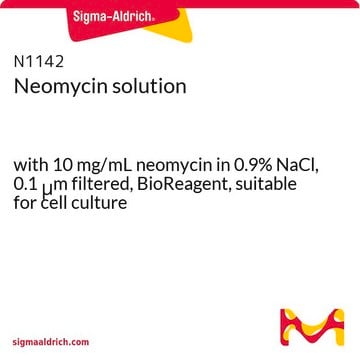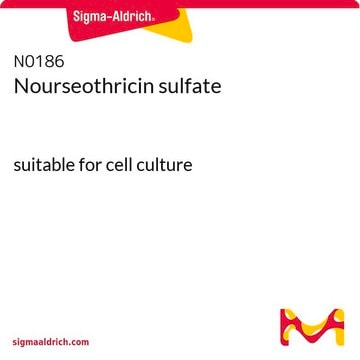Kluczowe dokumenty
A1720
G 418 disulfate salt
powder, non-animal origin, suitable for cell culture, BioReagent
Synonim(y):
Antibiotic G418
Wybierz wielkość
1150,00 zł
Wybierz wielkość
About This Item
1150,00 zł
Polecane produkty
Nazwa produktu
G 418 disulfate salt, powder, BioReagent, suitable for cell culture
linia produktu
BioReagent
Poziom jakości
Formularz
powder
aktywność optyczna
[α]/D (Specific Rotation: +104.4o (c=0.3% in H2O at 26oC))
siła działania
≥720 μg per mg (Dried basis)
masa cząsteczkowa
692.7
opakowanie
pkg of 1 g
pkg of 25 g
pkg of 5 g
metody
cell culture | mammalian: suitable
kolor
white to off-white
rozpuszczalność
H2O: 100 mg/mL (As a stock solution. Stock solutions should be stored at 2-8°C. Stable at 37°C for 8 days.)
spektrum działania antybiotyku
Gram-negative bacteria
Tryb działania
protein synthesis | interferes
temp. przechowywania
2-8°C
ciąg SMILES
OS(O)(=O)=O.OS(O)(=O)=O.CN[C@H]1[C@H](O)[C@@H](OC[C@@]1(C)O)O[C@H]2[C@H](N)C[C@H](N)[C@@H](O[C@H]3O[C@H]([C@H](C)O)[C@@H](O)[C@H](O)[C@H]3N)[C@@H]2O
InChI
1S/C20H40N4O10.2H2O4S/c1-6(25)14-11(27)10(26)9(23)18(32-14)33-15-7(21)4-8(22)16(12(15)28)34-19-13(29)17(24-3)20(2,30)5-31-19;2*1-5(2,3)4/h6-19,24-30H,4-5,21-23H2,1-3H3;2*(H2,1,2,3,4)/t6?,7-,8+,9+,10+,11-,12-,13-,14+,15+,16-,17-,18+,19-,20+;;/m0../s1
Klucz InChI
UHEPSJJJMTWUCP-NKCAIAFTSA-N
Szukasz podobnych produktów? Odwiedź Przewodnik dotyczący porównywania produktów
Opis ogólny
Zastosowanie
Działania biochem./fizjol.
Przestroga
Uwaga dotycząca przygotowania
Inne uwagi
Hasło ostrzegawcze
Danger
Zwroty wskazujące rodzaj zagrożenia
Zwroty wskazujące środki ostrożności
Klasyfikacja zagrożeń
Resp. Sens. 1 - Skin Sens. 1
Kod klasy składowania
11 - Combustible Solids
Klasa zagrożenia wodnego (WGK)
WGK 3
Środki ochrony indywidualnej
Eyeshields, Gloves, type N95 (US)
Wybierz jedną z najnowszych wersji:
Certyfikaty analizy (CoA)
Nie widzisz odpowiedniej wersji?
Jeśli potrzebujesz konkretnej wersji, możesz wyszukać konkretny certyfikat według numeru partii lub serii.
Masz już ten produkt?
Dokumenty związane z niedawno zakupionymi produktami zostały zamieszczone w Bibliotece dokumentów.
Produkty
Antibiotic kill curve is a dose response experiment in which mammalian cells are subjected to increasing amounts of selection antibiotic
Krzywa zabijania antybiotyków to eksperyment dawka-odpowiedź, w którym komórki ssaków są poddawane rosnącej ilości antybiotyku selekcyjnego.
Protokoły
Determine optimal antibiotic concentration for stable cell lines, ensuring efficient selection in transduced cells.
Stem Cell protocols for cryopreservation, thawing of cryopreserved stem cells and media preparation.
Active Filters
Nasz zespół naukowców ma doświadczenie we wszystkich obszarach badań, w tym w naukach przyrodniczych, materiałoznawstwie, syntezie chemicznej, chromatografii, analityce i wielu innych dziedzinach.
Skontaktuj się z zespołem ds. pomocy technicznej






